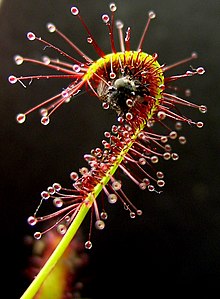Tentacle: Difference between revisions
→Tentacles in marine animals: Isn't 'squid' like 'sheep'? Quick perusal of squid suggests so. |
GrahamBould (talk | contribs) mNo edit summary |
||
| Line 12: | Line 12: | ||
The phylum [[mollusca]] includes many species with [[muscular hydrostat]]s in the form of tentacles and arms ([[octopuses]] do not have tentacles: they have arms). Tentacles are longer than arms and usually have suckers at their tips only. [[Squid]] and [[cuttlefish]] have eight arms like octopuses, and also two tentacles, which is one good way to distinguish squid from octopuses. |
The phylum [[mollusca]] includes many species with [[muscular hydrostat]]s in the form of tentacles and arms ([[octopuses]] do not have tentacles: they have arms). Tentacles are longer than arms and usually have suckers at their tips only. [[Squid]] and [[cuttlefish]] have eight arms like octopuses, and also two tentacles, which is one good way to distinguish squid from octopuses. |
||
The tentacles of the [[ |
The tentacles of the [[giant squid]] and [[colossal squid]] are particularly formidable, having powerful suckers and deadly [[teeth]] at the ends of the tentacle. The teeth of the giant squid are small, "bottle-cap" shaped [[circular]] saws, while the tentacles of the colossal squid wield two long rows of thick, sharp, finger-length screws of protruding bone. |
||
[[Cnidarian]]s, which include among others the [[jellyfish]]es, are another phylum with many tentaculated specimens. Cnidarians often have huge numbers of [[cnidocyte]]s on their tentacles. Cnidocytes are cells containing a coiled thread-like structure called ''nematocyst'', which can be fired at potential prey. |
[[Cnidarian]]s, which include among others the [[jellyfish]]es, are another phylum with many tentaculated specimens. Cnidarians often have huge numbers of [[cnidocyte]]s on their tentacles. Cnidocytes are cells containing a coiled thread-like structure called ''nematocyst'', which can be fired at potential prey. |
||
| Line 27: | Line 27: | ||
==Tentacles in plants== |
==Tentacles in plants== |
||
[[Image:Drosera_capensis_bend.JPG|thumb|Leaf and tentacle movement on ''[[Drosera |
[[Image:Drosera_capensis_bend.JPG|thumb|Leaf and tentacle movement on ''[[Drosera capensis]]'']] |
||
In [[carnivorous plant]]s, tentacles refer to the stalked glands of the upper surface of the [[leaf|leaves]]. On a [[Drosera|sundew]] plant, they are hairlike projections with a drop of |
In [[carnivorous plant]]s, tentacles refer to the stalked glands of the upper surface of the [[leaf|leaves]]. On a [[Drosera|sundew]] plant, they are hairlike projections with a drop of nectar-like glue which attract insects. When an insect is captured, the tentacles bend inward and the leaf rolls together as shown in the picture. The tentacles then secrete digestive [[enzyme]]s to dissolve and engulf the insect. |
||
==Tentacles in cultural context== |
==Tentacles in cultural context== |
||
The great differences between humans and the tentacle-bearing ''mollusca'' have led to tentacles being associated with inhumanity and disgust in legend and fiction. For examples, see: |
The great differences between humans and the tentacle-bearing ''mollusca'' have led to tentacles being associated with inhumanity and disgust in legend and fiction. For examples, see: |
||
*[[Tentacle rape]] |
* [[Tentacle rape]] |
||
*Purple Tentacle (see [[Day of the Tentacle]]) |
* Purple Tentacle (see [[Day of the Tentacle]]) |
||
*[[Cthulhu]] |
* [[Cthulhu]] |
||
*[[Emperor Ing]] |
* [[Emperor Ing]] |
||
Revision as of 12:49, 11 January 2007
 |
Tentacles can refer to the elongated flexible organs that are present in some animals, especially invertebrates, and sometimes to the hairs of the leaves of some insectivorous plants. Usually, they are used for feeding, feeling and grasping. Anatomically, they work like other muscular hydrostats.
Tentacles in marine animals
The phylum mollusca includes many species with muscular hydrostats in the form of tentacles and arms (octopuses do not have tentacles: they have arms). Tentacles are longer than arms and usually have suckers at their tips only. Squid and cuttlefish have eight arms like octopuses, and also two tentacles, which is one good way to distinguish squid from octopuses.
The tentacles of the giant squid and colossal squid are particularly formidable, having powerful suckers and deadly teeth at the ends of the tentacle. The teeth of the giant squid are small, "bottle-cap" shaped circular saws, while the tentacles of the colossal squid wield two long rows of thick, sharp, finger-length screws of protruding bone.
Cnidarians, which include among others the jellyfishes, are another phylum with many tentaculated specimens. Cnidarians often have huge numbers of cnidocytes on their tentacles. Cnidocytes are cells containing a coiled thread-like structure called nematocyst, which can be fired at potential prey.
Many species of the jellyfishlike ctenophores have two tentacles, while some have none. Their tentacles have adhesive structures called colloblasts or lasso cells. These cells burst open when prey comes in contact with the tentacle; sticky threads released from each of the colloblasts will then capture the food.
Bryozoa ("Moss animals") are tiny creatures with a ring of tentacles surrounding the mouth.
Tentacles in amphibians
Some wormlike amphibians have tentacles. The caecilians have two tentacles at their heads, which are probably used for the olfactory sense.
Tentacles in mammals
The star-nosed mole, Condylura cristata, possesses nasal tentacles which are mobile and incredibly sensitive, helping the animal to find its way about the burrow and detect prey.
Tentacles in plants

In carnivorous plants, tentacles refer to the stalked glands of the upper surface of the leaves. On a sundew plant, they are hairlike projections with a drop of nectar-like glue which attract insects. When an insect is captured, the tentacles bend inward and the leaf rolls together as shown in the picture. The tentacles then secrete digestive enzymes to dissolve and engulf the insect.
Tentacles in cultural context
The great differences between humans and the tentacle-bearing mollusca have led to tentacles being associated with inhumanity and disgust in legend and fiction. For examples, see:
- Tentacle rape
- Purple Tentacle (see Day of the Tentacle)
- Cthulhu
- Emperor Ing
